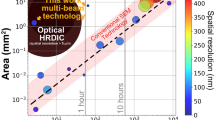Abstract
A microlithographic-marker experiment was conducted instead of a conventional kinetics study using thermogravimetry, to study the oxidation of pure Ni and a Ni-1 at.% Cr alloy. A composite marker, consisting of a 10-nm-thick Mo layer under a 150-nm-thick Pt layer, was designed, and the method for photolithographic deposition of inert markers is described. The micron scale of the marker eliminates any ambiguity in marker identification, which is frequently encountered with conventional markers, whose size may exceed that of the microstructural features controlling oxidation. Transverse-sectioning techniques were employed for TEM and SEM analysis to detect the markers. The regularity of the markers provides a more reliable demarcation of original interface positions. The position of the markers suggests that small additions of Cr significantly promote inward transport of oxygen. The presence of the markers appears to affect only marginally the oxidation kinetics and local oxide morphology.
Similar content being viewed by others
References
L. B. Pfeil,J. Iron Steel Inst. 119, 501 (1929).
A. Smigelskas and E. Kirkendall,Trans. AIME 171, 130 (1947).
B. L. Gleeson, D. L., Douglass, and F. Gesmundo,Oxid. Met. 31, 209 (1989).
E. M. Fryt, G. C. Wood, F. H. Stott, and D. P. Whittle,Oxid. Met. 23, 77 (1985).
H. M. Hindam and W. W. Smeltzer,Oxid. Met.,14, 337 (1980).
C. M. Cotell, K. Przybylski and G. L. Yurek, inFundamental Aspects of High Temperature Corrosion, Vol. 2, D. A. Shores and G. J. Yurek, eds. (The Electrochemical Society, Pennington, NJ, 1986), p. 103.
E. W. A. Young, H. E. Bishop, and J. H. deWit,Surf. Interface Anal. 9, 163 (1986).
T. A. Ramanarayanan, R. Ayer, R. Petkovic-Luton, and D. P. Leta,Oxid. Met. 29, 445 (1988).
L. W. Hobbs, H. T. Sawhill, and M. T. Tinker,Trans. Jpn. Inst. Metals JIMIS 3 Suppl., 115 (1983).
L. W. Hobbs, H. T. Sawhill, and M. T. Tinker,Rad. Effects 74, 229 (1983).
H. T. Sawhill, L. W. Hobbs, and M. T. Tinker,Adv. Ceram. 6, 128 (1983).
H. T. Sawhill and L. W. Hobbs, Proc. Int. Congr. on Metallic Corrosion, Toronto, Vol.1, 1984, p. 21.
C. K. Kim, S. K. Fan, and L. W. Hobbs,Microscopy of Oxidation, G. J. Lorimer, ed. (Institute of Metals, London, UK, 1991), p. 374.
S. B. Newcomb, W. M. Stobbs, and E. Metcalfe,Phil. Trans. R. Soc. London A 319, 191 (1986).
S. B. Newcomb, W. M. Stobbs, and E. Metcalfe,Phil. Trans. R. Soc. London A 319, 219 (1986).
S. B. Newcomb and W. M. Stobbs,Mater. Sci. Tech. 4, 384 (1988).
R. B. Marcus and T. T. Sheng,Transmission Electron Microscopy of Silicon VLSI Circuits and Structures (Wiley, New York, 1983).
K. Kowalska, E. Roszczynialska, and T. Werber,Oxid. Met. 15, 399 (1981).
G. Romeo, W. W. Smeltzer, and J. S. Kirkaldy,J. Electrochem. Soc., Solid State Sci. 118, 1336 (1971).
E. Bassous, H. N. Yu, and V. Maniscalco,J. Electrochem. Soc. 123, 1729 (1976).
E. W. A. Young and J. H. W. de Wit,Solid State Ionics, Vol. 16 (North-Holland, Amsterdam, 1985), p. 39.
K. P. R. Reddy, J. L. Smialek, and A. R. Cooper,Oxid. Met. 17, 429 (1982).
P. E. Doherty and R. S. Davis,J. Appl. Phys. 34, 619 (1963).
J. J. Randall and W. J. Bernard,J. Appl. Phys. 35, 1317 (1964).
H. M. Hindam and W. W. Smeltzer,Oxid. Met. 14, 337 (1980).
B. A. Pint, and L. W. Hobbs,Oxid. Met. 41, 203 (1994).
B. A. Pint, J. R. Martin, and L. W. Hobbs,Oxid. Met. 39, 167 (1993).
M. J. Graham, J. I. Eldrige, D. F. Mitchell, and R. J. Hussey,Mater. Sci. Forum 43, 207 (1989).
H. Schmalzried,Solid State Reactions, Monographs in Modern Chemistry, Vol. 12, (1980), p. 135.
H. Muller, G. Gyulai, W. K. Chu, and J. W. Mayer,J. Electrochem. Soc. 122, 1234 (1975).
F. Brown and W. D. Mackintosh,J. Electrochem. Soc. 120, 1096 (1973).
Author information
Authors and Affiliations
Rights and permissions
About this article
Cite this article
Kim, C.K. The use of photolithographic marker technique for the probe of the diffusing species in high-temperature oxidation. Oxid Met 45, 133–152 (1996). https://doi.org/10.1007/BF01046823
Received:
Revised:
Issue Date:
DOI: https://doi.org/10.1007/BF01046823




